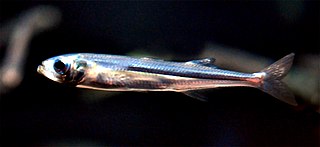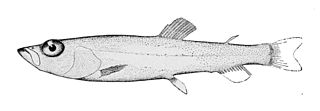
Brackish water, also sometimes termed brack water, is water occurring in a natural environment having more salinity than freshwater, but not as much as seawater. It may result from mixing seawater with fresh water together, as in estuaries, or it may occur in brackish fossil aquifers. The word comes from the Middle Dutch root "brak". Certain human activities can produce brackish water, in particular civil engineering projects such as dikes and the flooding of coastal marshland to produce brackish water pools for freshwater prawn farming. Brackish water is also the primary waste product of the salinity gradient power process. Because brackish water is hostile to the growth of most terrestrial plant species, without appropriate management it is damaging to the environment.

Smelts are a family of small fish, the Osmeridae, found in the North Atlantic and North Pacific Oceans, as well as rivers, streams and lakes in Europe, North America and Northeast Asia. They are also known as freshwater smelts or typical smelts to distinguish them from the related Argentinidae, Bathylagidae, and Retropinnidae.

The Osmeriformes are an order of ray-finned fish that includes the true or freshwater smelts and allies, such as the galaxiids and noodlefishes; they are also collectively called osmeriforms. They belong to the teleost superorder Protacanthopterygii, which also includes pike and salmon, among others. The order's name means "smelt-shaped", from Osmerus + the standard fish order suffix "-formes". It ultimately derives from Ancient Greek osmé + Latin forma, the former in reference to the characteristic aroma of the flesh of Osmerus.

Overfishing is the removal of a species of fish from a body of water at a rate that the species cannot replenish, resulting in those species becoming underpopulated in that area. In a Food and Agriculture Organization of the United Nations 2018 report, the FAO estimates that one-third of world fish stocks were overfished by 2015. Over 30 billion euros in public subsidies are directed to fisheries annually.
The pelagic zone consists of the water column of the open ocean, and can be further divided into regions by depth, as illustrated on the right. The word "pelagic" is derived from Ancient Greek πέλαγος (pélagos) 'open sea'. The pelagic zone can be thought of in terms of an imaginary cylinder or water column that goes from the surface of the sea almost to the bottom. Conditions in the water column change with distance from the surface (depth): the pressure increases; the temperature and amount of light decreases; the salinity and amount of dissolved oxygen, as well as micronutrients such as iron, magnesium and calcium, all change.

The Thames Estuary is where the River Thames meets the waters of the North Sea, in the south-east of Great Britain.

The herring smelts or argentines are a family, Argentinidae, of marine smelts. They are similar in appearance to smelts but have much smaller mouths.
Bathylagus antarcticus, the Antarctic deep-sea smelt, is a deep-sea smelt found in all the southern oceans as far south as Antarctica, to depths of 4,000 metres (13,000 ft). This species grows to a length of 14 centimetres (5.5 in) SL.
The Feast of the Seven Fishes is an Italian-American celebration of Christmas Eve with dishes of fish and other seafood.
Bathylagus is a genus of deep-sea smelts, some species of which are noted for having stylophthalmine larvae.

The Argentiniformes are an order of ray-finned fish whose distinctness was recognized only fairly recently. In former times, they were included in the Osmeriformes as suborder Argentinoidei. That term refers only to the suborder of marine smelts and barreleyes in the classification used here, with the slickheads and allies being the Alepocephaloidei. These suborders were treated as superfamilies Argentinoidea and Alepocephaloidea, respectively, when the present group was still included in the Osmeriformes.

Leptochilichthys is a genus of marine smelts containing four species. Leptochilichthys is the only genus in the former family Leptochilichthyidae but is now included within the broader family Alepocephalidae.

The Mediterranean sand smelt, Atherina hepsetus, is a species of fish in the family Atherinidae.

The sand smelt is a species of marine fish of the family Atherinidae, common in the northeastern Atlantic from the Danish straits, where it is rare, and Scotland to the Canary Islands and the western Mediterranean Sea. Sand smelt are small, pelagic fishes which are found in coastal areas and in estuaries. They are a schooling species which undertake seasonal migrations in the Atlantic. They are carnivorous and prey on small crustaceans and fish larvae. Reproduction takes place in the spring and summer, in the North Sea and the English Channel spawning takes place over midsummer.
Glossanodon is a genus of fishes in the family Argentinidae.
Bathylagichthys is a species of deep-sea smelts.
Anatoly Petrovich Andriyashev was a Soviet Russian ichthyologist, marine biologist, and zoogeographist, notable for his studies of marine fauna of the Arctic and the Northern Pacific.

The southern smoothtongue or California smoothtongue is a type of ray-finned fish in the deep-sea smelt family Bathylagidae, that can grow to a length of 15 centimetres (6 in) TL. This fish is native to the northeastern Pacific Ocean from British Columbia to Oregon, and the Gulf of California where it is found at depths of 100 to 850 metres.











